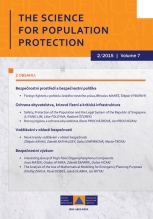INTERESTING GROUP OF HIGH-TOXIC ORGANOPHOSPHORUSCOMPOUNDS
DOI:
https://doi.org/10.71934/Keywords:
Intermediate volatility agent, organophosphorus agents, chemical warfare agents, supertoxicAbstract
In the second half of the last century, a piece of information appeared that the U.S.
planned to introduce a new supertoxic intermediate volatility agent (IVA) into the Armed
Forces with the intent to gradually replace sarin (GB) and VX agent. The aim of this change
should have been the elimination of disadvantages, low persistence of sarin in the field in
summer conditions and, as for VX agent low efficiency in overcoming any protective barrier.
The introduction of this substance has been closely connected with a new technology related to
munitions called binary munitions. Binary technology is based on charging munitions using two
independent harmless substances which are separated in two tanks. Both substances mix during
the grenade or rocket flight and form a toxic compound. This mixing can be achieved by e.g. the
rupture of a membrane between the tanks due to inertial forces, and in case of artillery rockets
their rotation is employed. The binary munitions mostly contained sarin, VX and mustard gas.
The “-2” character was then added to the code and so e.g. the charge the binary sarin was
marked as GB-2. As to the new intermediate volatility agent, the principle of binary munitions
had not been described until the beginning of the research. This information was an impulse for
commencement and realization of research into the properties of a new agent or, if need be,
a group of agents owing to defence and protection, for obvious reasons. The targeted research
was initiated in 1983.
Downloads
Published
Issue
Section
License
Copyright (c) 2025 The Science For Population Protection

This work is licensed under a Creative Commons Attribution-NonCommercial-NoDerivatives 4.0 International License.
Published under license


